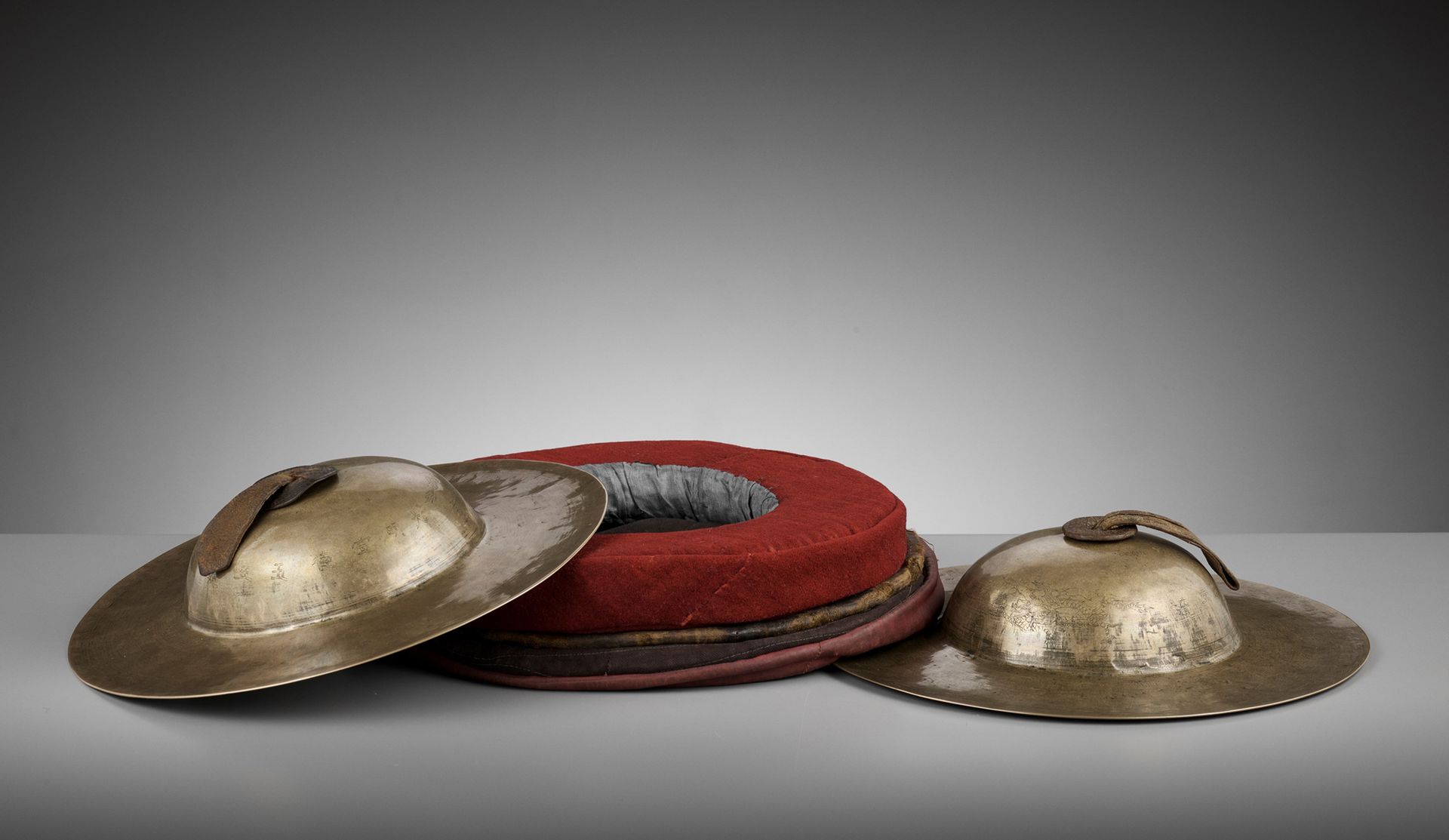Description
A PAIR OF BRONZE CYMBALS, BO, XUANDE MARK AND PERIOD, DATED 1431
A PAIR OF BRONZE CYMBALS, BO, XUANDE MARK AND PERIOD, DATED 1431 China, 1426-1435. Each with a broad, flat rim that is slightly curved upward, and domed top finely incised with two sinuously coiled four-clawed dragons chasing a flaming pearl. The other side of the top is neatly incised with a seven-character mark da Ming Xuande wu nianzhi (made in the fifth year of the Xuande reign of the Great Ming, corresponding to 1431) and of the period. Inscriptions: To each cymbal, ‘da Ming Xuande wu nian zao’ (made in the fifth year of the Xuande reign of the Great Ming) Provenance: From a noted Swiss private collection. Condition: Excellent condition, commensurate with age. Extensive old wear and casting flaws, minor dings and dents, shallow surface scratches, soiling, and warping. The textiles with significant traces of use, wear, soiling, and losses. Weight: 800 g and 805 g (the cymbals) Dimensions: Diameter 31.5 cm and 31.7 cm With leather straps, two textile paddings, and a textile bag, all probably dating from the later 19th to the earlier 20th century. (5) Bo is the generic name for pairs of cymbals that come in a variety of sizes, all with rims that curl upward at the edges. Bo are used together with gongs and drums for military music and play a prominent role in opera productions, where they accent the actors’ movements. Several playing techniques may be employed: the discs may be clashed together or held horizontally, with one raking across the other to produce a sustained rolling sound. In Tibetan processions and dance, drums and cymbals set up basic rhythmic patterns for wind instruments, and in temple settings are used with bells to accompany chant. Literature comparison: A pair of bronze cymbals from the Xuande period is in the Tibet Museum in Lhasa. A pair of bronze cymbals from the Jin dynasty is in the Shaanxi Provincial Museum. Compare a pair of bronze cymbals dated to the late 17th century in the collection of the Metropolitan Museum of Art, accession number 2003.465a–d. Auction result comparison: Compare a bronze ghanta, also with a Xuande mark and of the period, at Sotheby’s Hong Kong in Fine Chinese Ceramics & Works of Art on 9 October 2012, lot 3111, sold for HKD 980,000, and another at Christie’s Hong Kong in The Perfect Countenance – Fine Buddhist Works of Art on 31 May 2017, lot 2809, sold for HKD 687,500. 大明宣德五年一副銅鈸,宣德款及年代 中國, 1431年。銅鈸一對,落款自右至左為“大明宣德五年造”,刻款,德字少一橫,鈸腹刻有雙龍戲珠圖案,一大一小。 款識:大明宣德五年造 來源:瑞士知名私人收藏。 品相:狀況極佳,與年齡相稱。 大面積磨損和鑄造缺陷、輕微的凹痕、表面淺劃痕、污跡和翹曲。布料有明顯使用痕跡、磨損、弄髒和丟失痕跡的紡織品。 重量:分別800 克與 805 克 尺寸:直徑分別為 31.5 厘米 與 31.7 厘米 皮革肩帶、兩個紡織襯墊和一個紡織袋,應爲十九世紀末至二十世紀早期。(5) 鈸是各種尺寸的鑔片的通用名稱,是一種常見的打擊樂器。所有镲片的邊緣都向上捲曲。銅鈸與鑼鼓一起用於軍樂,在歌劇製作中扮演重要角色,它們強調角色的動作。可以採用幾種演奏技巧:可以將圓盤碰撞在一起或水平放置,其中一個在另一個上傾斜以產生持續的滾動聲音。 在藏族遊行和舞蹈中,鼓和鈸為管樂器決定了基本的節奏模式,在寺廟中用鐘聲伴隨著誦經。 文獻比較:一副宣德銅鈸可見拉薩西藏博物館;一副金代銅鈸見陝西省博物館;比較一幅銅鈸,十七世紀,見大都會博物館,編號2003.465a–d。 拍賣結果比較:比較一宣德款及年代的銅鈴,見香港蘇富比Fine Chinese Ceramics & Works of Art 2012年10月9日 lot 3111, 售價HKD 980,000;另一件見香港佳士得The Perfect Countenance – Fine Buddhist Works of Art 2017年5月31日 lot 2809, 售價HKD 687,500。
18
A PAIR OF BRONZE CYMBALS, BO, XUANDE MARK AND PERIOD, DATED 1431
